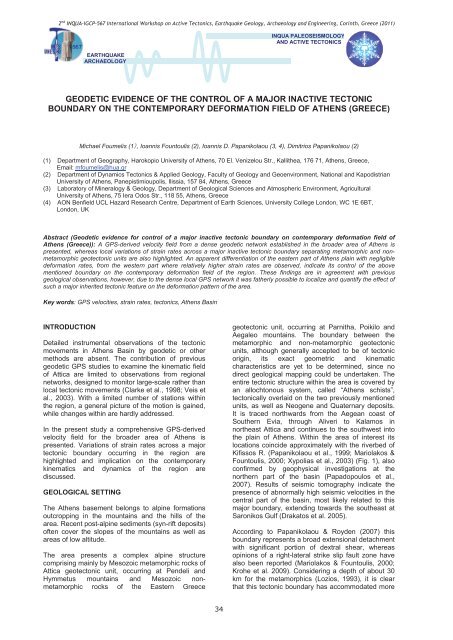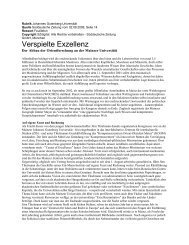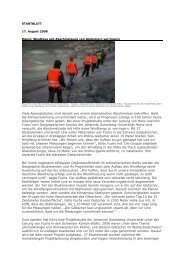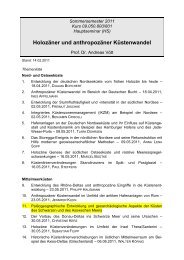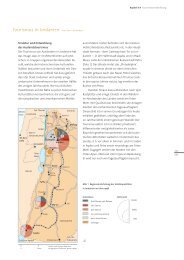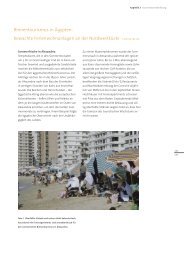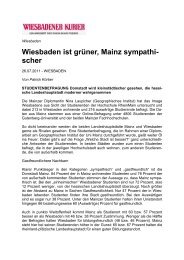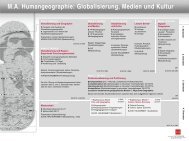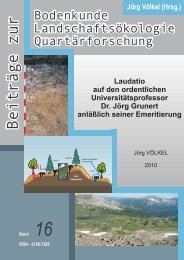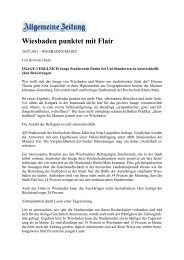Proceedings - Johannes Gutenberg-Universität Mainz
Proceedings - Johannes Gutenberg-Universität Mainz
Proceedings - Johannes Gutenberg-Universität Mainz
You also want an ePaper? Increase the reach of your titles
YUMPU automatically turns print PDFs into web optimized ePapers that Google loves.
2 nd INQUA-IGCP-567 International Workshop on Active Tectonics, Earthquake Geology, Archaeology and Engineering, Corinth, Greece (2011)<br />
EARTHQUAKE<br />
ARCHAEOLOGY<br />
INQUA PALEOSEISMOLOGY<br />
AND ACTIVE TECTONICS<br />
GEODETIC EVIDENCE OF THE CONTROL OF A MAJOR INACTIVE TECTONIC<br />
BOUNDARY ON THE CONTEMPORARY DEFORMATION FIELD OF ATHENS (GREECE)<br />
Michael Foumelis (1, Ioannis Fountoulis (2), Ioannis D. Papanikolau (3, 4), Dimitrios Papanikolaou (2)<br />
(1) Department of Geography, Harokopio University of Athens, 70 El. Venizelou Str., Kallithea, 176 71, Athens, Greece,<br />
Email: mfoumelis@hua.gr<br />
(2) Department of Dynamics Tectonics & Applied Geology, Faculty of Geology and Geoenvironment, National and Kapodistrian<br />
University of Athens, Panepistimioupolis, Ilissia, 157 84, Athens, Greece<br />
(3) Laboratory of Mineralogy & Geology, Department of Geological Sciences and Atmospheric Environment, Agricultural<br />
University of Athens, 75 Iera Odos Str., 118 55, Athens, Greece<br />
(4) AON Benfield UCL Hazard Research Centre, Department of Earth Sciences, University College London, WC 1E 6BT,<br />
London, UK<br />
Abstract (Geodetic evidence for control of a major inactive tectonic boundary on contemporary deformation field of<br />
Athens (Greece)): A GPS-derived velocity field from a dense geodetic network established in the broader area of Athens is<br />
presented, whereas local variations of strain rates across a major inactive tectonic boundary separating metamorphic and nonmetamorphic<br />
geotectonic units are also highlighted. An apparent differentiation of the eastern part of Athens plain with negligible<br />
deformation rates, from the western part where relatively higher strain rates are observed, indicate its control of the above<br />
mentioned boundary on the contemporary deformation field of the region. These findings are in agreement with previous<br />
geological observations, however, due to the dense local GPS network it was fatherly possible to localize and quantify the effect of<br />
such a major inherited tectonic feature on the deformation pattern of the area.<br />
Key words: GPS velocities, strain rates, tectonics, Athens Basin<br />
INTRODUCTION<br />
Detailed instrumental observations of the tectonic<br />
movements in Athens Basin by geodetic or other<br />
methods are absent. The contribution of previous<br />
geodetic GPS studies to examine the kinematic field<br />
of Attica are limited to observations from regional<br />
networks, designed to monitor large-scale rather than<br />
local tectonic movements (Clarke et al., 1998; Veis et<br />
al., 2003). With a limited number of stations within<br />
the region, a general picture of the motion is gained,<br />
while changes within are hardly addressed.<br />
In the present study a comprehensive GPS-derived<br />
velocity field for the broader area of Athens is<br />
presented. Variations of strain rates across a major<br />
tectonic boundary occurring in the region are<br />
highlighted and implication on the contemporary<br />
kinematics and dynamics of the region are<br />
discussed.<br />
GEOLOGICAL SETTING<br />
The Athens basement belongs to alpine formations<br />
outcropping in the mountains and the hills of the<br />
area. Recent post-alpine sediments (syn-rift deposits)<br />
often cover the slopes of the mountains as well as<br />
areas of low altitude.<br />
The area presents a complex alpine structure<br />
comprising mainly by Mesozoic metamorphic rocks of<br />
Attica geotectonic unit, occurring at Pendeli and<br />
Hymmetus mountains and Mesozoic nonmetamorphic<br />
rocks of the Eastern Greece<br />
geotectonic unit, occurring at Parnitha, Poikilo and<br />
Aegaleo mountains. The boundary between the<br />
metamorphic and non-metamorphic geotectonic<br />
units, although generally accepted to be of tectonic<br />
origin, its exact geometric and kinematic<br />
characteristics are yet to be determined, since no<br />
direct geological mapping could be undertaken. The<br />
entire tectonic structure within the area is covered by<br />
an allochtonous system, called “Athens schists”,<br />
tectonically overlaid on the two previously mentioned<br />
units, as well as Neogene and Quaternary deposits.<br />
It is traced northwards from the Aegean coast of<br />
Southern Evia, through Aliveri to Kalamos in<br />
northeast Attica and continues to the southwest into<br />
the plain of Athens. Within the area of interest its<br />
locations coincide approximately with the riverbed of<br />
Kifissos R. (Papanikolaou et al., 1999; Mariolakos &<br />
Fountoulis, 2000; Xypolias et al., 2003) (Fig. 1), also<br />
confirmed by geophysical investigations at the<br />
northern part of the basin (Papadopoulos et al.,<br />
2007). Results of seismic tomography indicate the<br />
presence of abnormally high seismic velocities in the<br />
central part of the basin, most likely related to this<br />
major boundary, extending towards the southeast at<br />
Saronikos Gulf (Drakatos et al. 2005).<br />
According to Papanikolaou & Royden (2007) this<br />
boundary represents a broad extensional detachment<br />
with significant portion of dextral shear, whereas<br />
opinions of a right-lateral strike slip fault zone have<br />
also been reported (Mariolakos & Fountoulis, 2000;<br />
Krohe et al. 2009). Considering a depth of about 30<br />
km for the metamorphics (Lozios, 1993), it is clear<br />
that this tectonic boundary has accommodated more<br />
34


